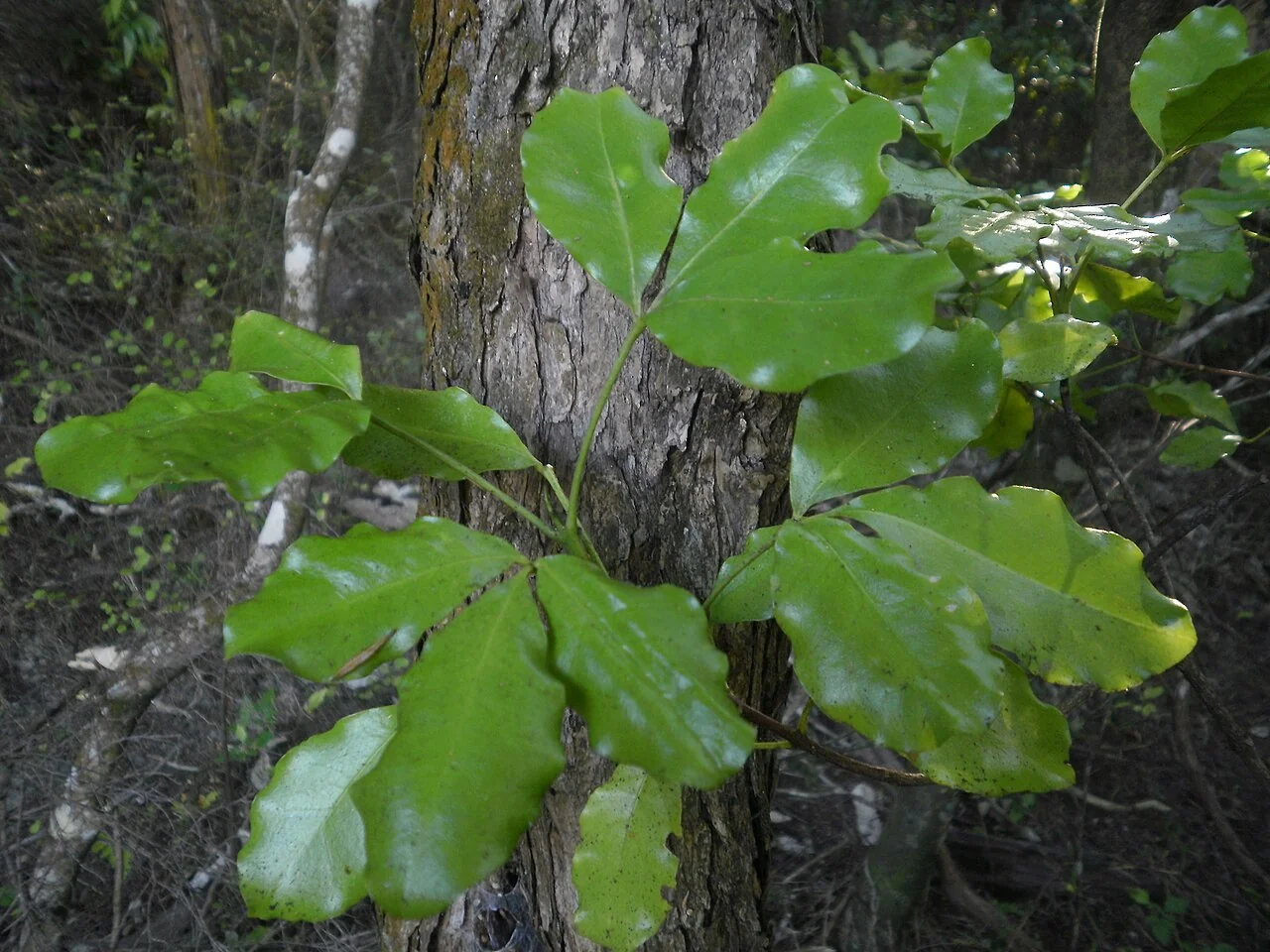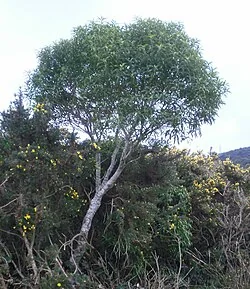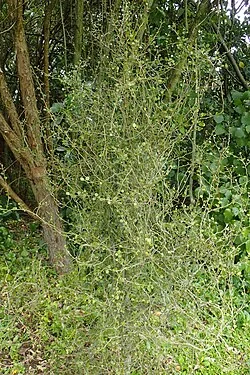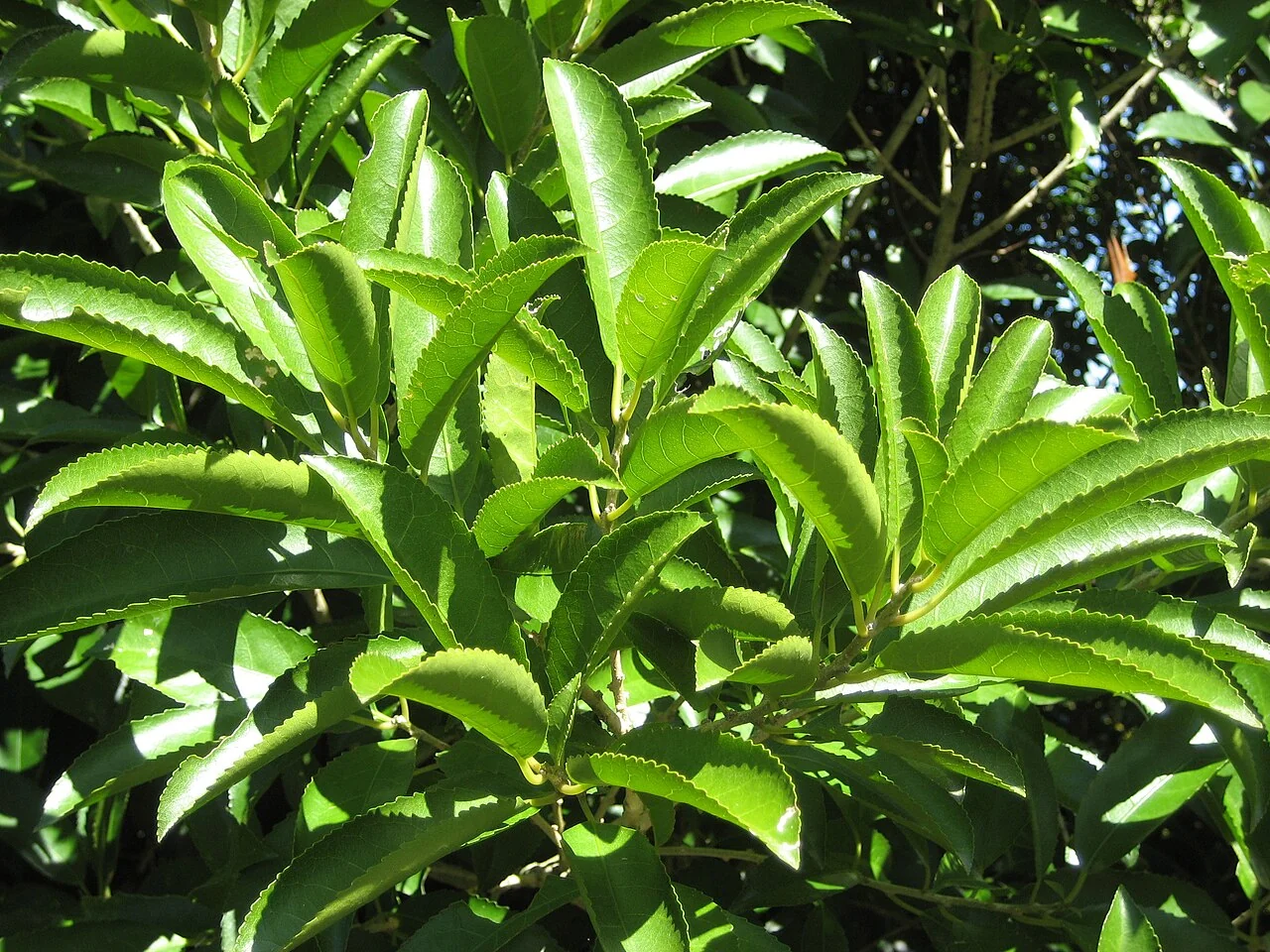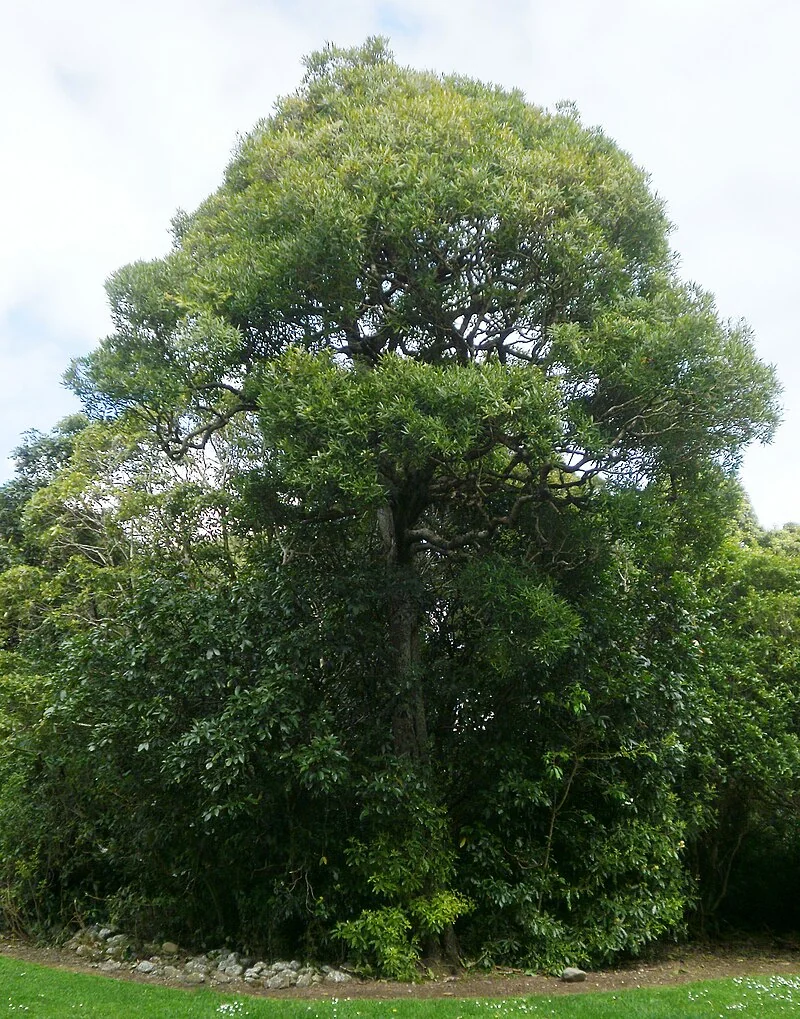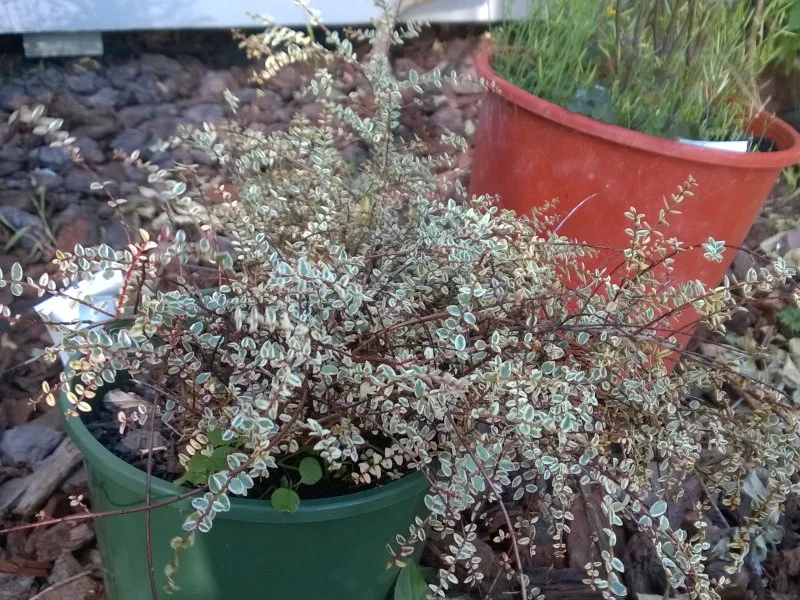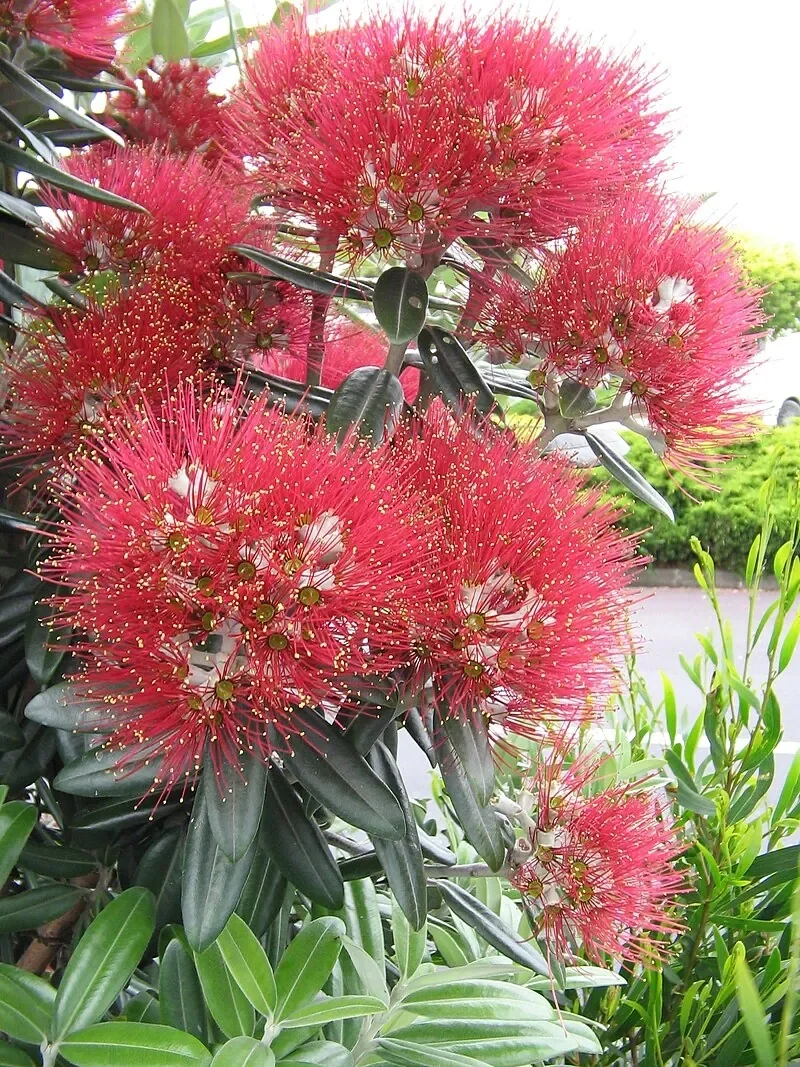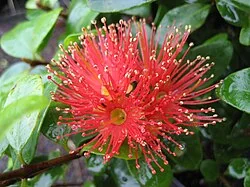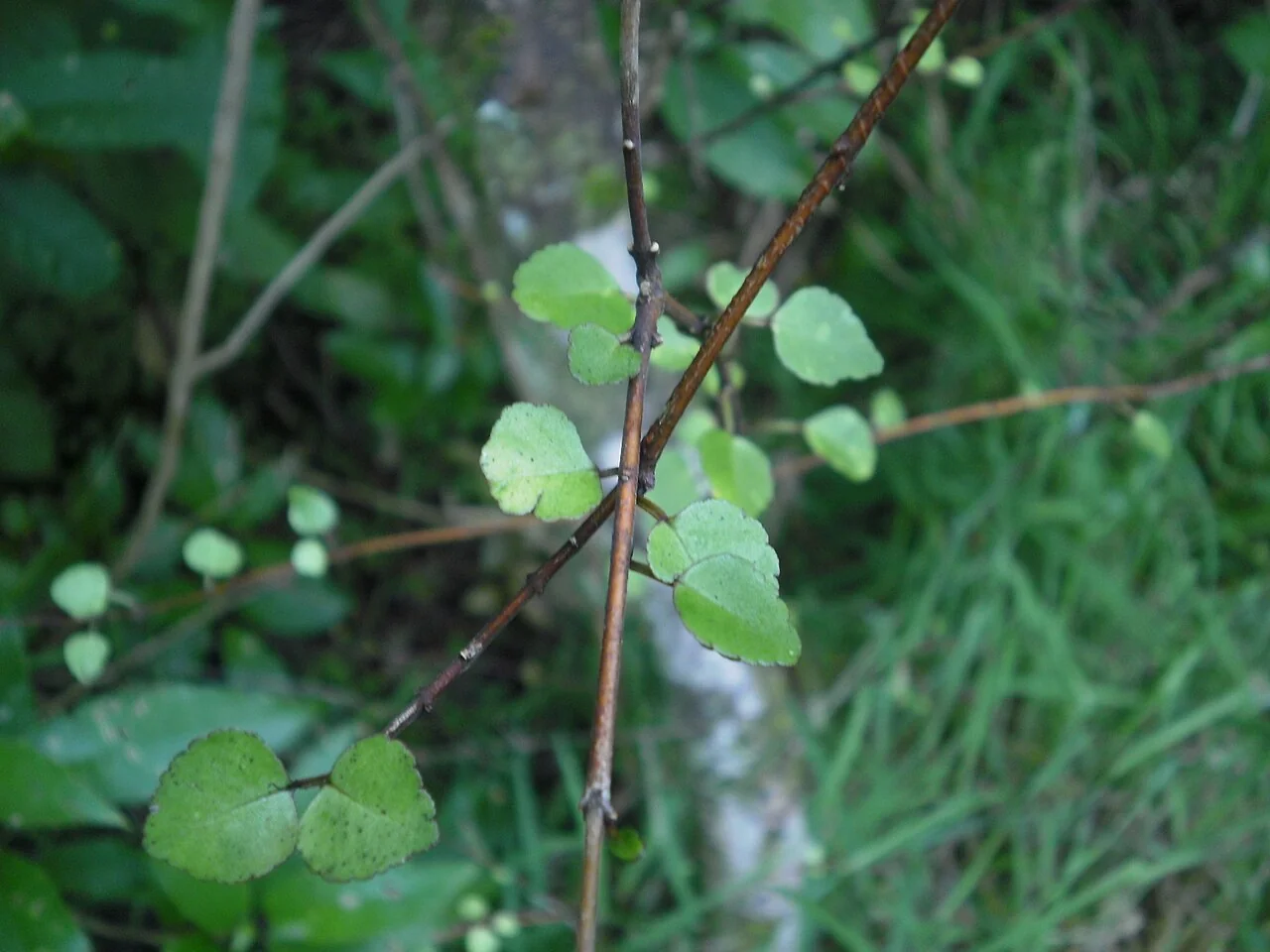
Poataniwha
Melicope simplex
Poataniwha is a fascinating and hardy native shrub, well-known for its divaricating branches that form a dense, tangled mass. A member of the citrus family, its small, round leaves release a pleasant citrus scent when crushed. This adaptable plant is found in a variety of habitats throughout New Zealand, from coastal areas to lowland forests. It produces small, greenish-white flowers in spring, followed by tiny black seeds that are a food source for birds among New Zealand's native shrubs.

Plant Description
Botanical Features
Poataniwha (Melicope simplex) is an endemic shrub native to New Zealand, characterized by its divaricating (interlacing) branches and small, round, leathery leaves. It can grow up to 4 meters high. The adult leaves are small (1-2 cm long), thick, leathery, and nearly circular with shallowly rounded teeth on their margins. When crushed, the leaves emit an aromatic citrus smell due to visible oil glands on their underside. It produces greenish-white flowerheads in spring, followed by tiny black seedheads. The fruit consists of dry, wrinkled capsules that eject black seeds when they open. It is found in the margins of coastal and lowland forests throughout New Zealand.
Quick Facts
Plant Specifications
| Scientific Name | Melicope simplex |
|---|---|
| Common Name | Poataniwha |
| Family | Rutaceae |
| Height | Up to 4 m |
| Spread | 1-2.5 m |
| Water Needs | Moderate, well-drained soil |
| Light | Full sun to partial shade |
| Frost Tolerance | Hardy |
| Salt Tolerance | Low; requires protection from salt exposure |
| Growth Rate | Moderate |
| Lifespan | Long |
Climate Best Suited to
Poataniwha (Melicope simplex) is found naturally throughout New Zealand in diverse habitats from coastal areas to lowland forests. It thrives in temperate maritime climates with moderate rainfall and can adapt to various climatic conditions. This hardy shrub tolerates both drought and periods of higher moisture, making it exceptionally versatile.
Regional Suitability
| City | Climate Suitability |
|---|---|
| Whangārei | Ideal |
| Auckland | Ideal |
| Hamilton | Ideal |
| Tauranga | Ideal |
| Rotorua | Ideal |
| Gisborne | Ideal |
| New Plymouth | Ideal |
| Napier | Ideal |
| Whanganui | Ideal |
| Palmerston North | Ideal |
| Wellington | Ideal |
| Nelson | Ideal |
| Christchurch | Ideal |
| Dunedin | Ideal |
| Invercargill | Ideal |
Natural Habitat
Diverse Habitats
Understand the natural habitat of Poataniwha (Melicope simplex), including its wide geographical distribution, preferred environmental conditions, and the diverse types of ecosystems where it thrives. This knowledge is crucial for successful cultivation and understanding its ecological role.
- Geographical distribution throughout New Zealand from coastal to lowland forest environments.
- Preferred habitat types including forest edges, coastal areas, and disturbed sites.
- Associated plant communities and typical ecosystem companions.
Plant Conservation
Melicope simplex, commonly known as poataniwha, is a plant species native and endemic to New Zealand. As of 2017 and 2023, its conservation status is classified as "Not Threatened." While some Melicope species found in Hawaii are listed as endangered due to habitat loss and competition from invasive non-native plants, this does not apply to Melicope simplex.
Growing Requirements
Soil Requirements
Poataniwha is very adaptable and can grow in a wide range of soils, including heavy clay. It prefers well-draining soil but can tolerate periods of wetness. It is a great choice for difficult areas in the garden where other plants may struggle.
Light Requirements
This shrub will grow in full sun or partial shade. For the densest growth and best form, a position in full sun is ideal. In insufficient light, it may become more open and sparse.
Water Requirements
Once established, Poataniwha is drought-tolerant. It will benefit from deep watering every 2-3 weeks during very dry periods but be careful not to overwater. It is well-suited to low-water garden designs.
Planting Guide
-
Best Time to Plant
Plant in spring or autumn when temperatures are moderate and moisture is more reliable. This allows excellent root establishment before facing summer heat or winter cold.
-
Choosing a Location
Choose a sunny or partly shaded location with good drainage. This adaptable shrub tolerates various soil types and challenging conditions, making it ideal for difficult garden areas.
-
Planting Steps
Dig a hole twice the width of the root ball. Place the plant at the same depth as in the pot. Backfill with existing soil (amendment usually unnecessary), firm gently, and water thoroughly. Mulch lightly around the base.
Ecological Significance
Ecosystem Roles
Poataniwha (Melicope simplex) plays a vital role in New Zealand's native ecosystems, serving as a crucial habitat provider for small wildlife while supporting pollinator networks and seed dispersal systems through its distinctive divaricating form.
- Dense divaricating branches provide essential shelter for small native birds and lizards
- Flowers attract native bees and beneficial insects during flowering period
- Seeds provide important food source for native birds, supporting ecosystem health
- Creates protective microhabitats within larger native plant communities
- Important component of coastal and lowland forest understory ecosystems
Uses and Significance
Garden Uses
- Outstanding specimen plant for native gardens and coastal landscapes
- Perfect for creating impenetrable wildlife-friendly hedges and barriers
- Excellent for habitat gardens providing shelter for small birds and lizards
- Ideal for low-maintenance and drought-tolerant garden designs
- Valuable for erosion control on slopes and challenging sites
Traditional Knowledge
Known to Māori as Poataniwha, this shrub represents the practical wisdom of traditional plant knowledge, particularly valued for its medicinal properties and ecological functions.
- Traditional medicinal plant - leaves used to treat toothache and other ailments
- Symbol of adaptation and resilience in challenging environments
- Important component of traditional ecological knowledge
Ecologically, Poataniwha serves as a crucial habitat provider, with its tangled divaricating branches creating safe refuges for native wildlife while supporting pollinators and seed dispersers.
Landscaping Applications
Unique Design Element
Discover how Poataniwha (Melicope simplex) can be effectively integrated into various landscaping designs. This section offers creative ideas and practical advice for using this unique divaricating shrub to enhance both the beauty and ecological value of your outdoor spaces.
- Design ideas for native gardens, coastal landscapes, and wildlife habitats.
- Best uses for barriers, hedging, and habitat creation.
- Combining with other native plants for authentic ecosystem restoration.
Seasonal Care Calendar
Spring
New growth appears throughout the divaricating branches. This is an excellent time for planting and for taking cuttings. Apply a balanced native plant fertilizer to encourage strong growth.
Summer
Small, greenish-white flowers appear in clusters, attracting native bees and beneficial insects. Water only during extended drought periods. The citrus-scented leaves are most fragrant in warm weather.
Autumn
Seed capsules form and split open to reveal small black seeds. Birds actively feed on these seeds. This is another excellent time for planting as conditions cool.
Winter
The plant enters dormancy with minimal water requirements. Winter is the ideal time for pruning to shape the plant or remove any dead branches. Hardy frost tolerance means little protection needed.
When to Prune and How Much
Pruning Guidelines
Poataniwha (Melicope simplex) requires minimal pruning to maintain its natural divaricating form. The tangled, interlacing branching pattern is this shrub's distinctive characteristic and should be preserved.
- Light pruning in winter during dormancy for shape maintenance
- Remove any dead, damaged, or diseased branches at any time
- Trim only to control size or remove growth extending beyond desired boundaries
- Preserve the natural divaricating character - avoid heavy pruning
- Young plants benefit from light tip pruning to encourage dense branching
- Use clean, sharp tools to prevent disease transmission
The distinctive tangled growth habit is the shrub's primary ornamental feature and should be appreciated rather than pruned away.
How to Grow Poataniwha
Growing Poataniwha successfully requires understanding its natural habitat preferences and unique growth characteristics. This distinctive native shrub, with its interlacing divaricating branches and small leathery leaves, adapts well to cultivation when provided with appropriate conditions. As one of only two New Zealand representatives of the citrus family, Poataniwha offers aromatic foliage and valuable habitat for native insects. The plant's naturally compact form and tolerance for trimming make it an excellent structural element in native gardens, while its spring flowers provide important nectar sources for small pollinators.
From Seed
Seed propagation is the primary method for growing Poataniwha, though patience is required as germination can be variable and slow. Fresh seed collection and immediate sowing are critical for success, as seeds lose viability quickly when stored. Understanding the plant's natural seed cycle and optimal sowing conditions improves success rates significantly.
- Collect ripe seed capsules in late summer to early autumn when they naturally split open to reveal large dark seeds
- Harvest seeds immediately upon capsule opening, as viability decreases rapidly with age
- Extract seeds carefully from the dry capsules, removing any chaff or capsule fragments
- Sow fresh seeds immediately in a well-draining seed-raising mix containing equal parts peat moss and perlite
- Cover seeds lightly with a thin layer of fine vermiculite or sifted seed mix, approximately 2-3mm deep
- Keep consistently moist but not waterlogged, using bottom watering to prevent seed displacement
- Maintain temperatures between 18-22°C and provide bright indirect light for optimal germination conditions
- Be patient as germination can take many months and success rates can be variable even with fresh seed
- Once germinated, allow seedlings to develop several sets of true leaves before transplanting to individual containers
- Gradually acclimatize young plants to outdoor conditions over several weeks before final planting
From Cuttings
Semi-hardwood cuttings provide a more reliable propagation method when seed is unavailable or when maintaining specific plant characteristics. This method works best during the active growing season when plants are producing vigorous new growth.
- Take semi-hardwood cuttings in late spring to early summer from healthy, non-flowering shoots
- Select current season's growth that has begun to firm up but isn't fully woody
- Cut 8-12cm long sections just below a node, ensuring each cutting has several leaf pairs
- Remove lower leaves to prevent rot while retaining 4-6 leaves at the cutting tip
- Dip cutting bases in rooting hormone powder containing IBA at 3000ppm concentration for woody shrubs
- Plant in a free-draining propagation mix of 50% peat moss and 50% perlite or coarse sand
- Maintain high humidity using a propagation dome while ensuring adequate air circulation
- Provide bright indirect light and consistent temperatures around 20-24°C
- Keep propagation medium consistently moist but never waterlogged to prevent fungal issues
- Expect rooting within 6-10 weeks, indicated by new growth or resistance when gently tugged
- Once well-rooted, gradually acclimatize cuttings to normal growing conditions over 2-3 weeks
Transplanting and Establishment
Successfully establishing young Poataniwha plants requires careful attention to site selection and initial care. The plant's eventual size and growth habit should be considered when choosing permanent locations in the garden.
- Choose well-drained sites with good air circulation, avoiding waterlogged or very dry locations
- Plant during cooler months in autumn or early spring to reduce transplant stress
- Dig planting holes twice as wide as the root ball and at the same depth as the container
- Backfill with native soil amended with compost to improve drainage and nutrition
- Water thoroughly after planting and maintain consistent moisture during the first growing season
- Apply organic mulch around plants to conserve moisture and suppress weeds
- Provide temporary wind protection for young plants in exposed locations
- Space plants 1.5-2 meters apart to allow for mature spread and good air circulation
Garden Management
Poataniwha responds well to careful pruning and shaping, allowing gardeners to maintain desired size and form while preserving the plant's natural character. Regular maintenance keeps plants healthy and attractive while supporting their role as habitat providers.
- Prune lightly with secateurs rather than hedge clippers to maintain natural branching patterns
- Trim annually after flowering to control size while preserving next year's flower buds
- Remove any dead, damaged, or crossing branches to improve air circulation and plant health
- Maintain plants at 1.2-2 meters height for best garden performance, though they can grow taller naturally
- Encourage dense growth by light tip pruning of young shoots during the growing season
- Monitor for pest issues and treat promptly, though plants are generally quite hardy and disease-resistant
- Fertilize lightly in spring with slow-release organic fertilizer if growth appears poor
Pests and Diseases
Poataniwha (Melicope simplex) is exceptionally hardy with outstanding natural resistance to virtually all pests and diseases. This tough shrub rarely requires intervention for health problems.
Rare Issues
- Scale insects: Very occasionally may appear, but rarely cause significant damage
- Aphids: Extremely rare, may appear on new growth in unusual circumstances
- Fungal problems: Extremely rare due to excellent natural disease resistance
Environmental Stressors
- Waterlogged soil: Prolonged waterlogging can stress plants in heavy clay
- Extreme drought: Very young plants may need water during severe drought
- Physical damage: Mechanical damage from garden equipment
Prevention
This shrub's exceptional hardiness means providing basic growing conditions is usually sufficient. Good drainage and appropriate siting prevent most potential issues.
Cultural Significance
Melicope simplex, commonly known as Poataniwha, is an endemic shrub native to New Zealand. It is characterized by its divaricating branches and small, round, leathery leaves that emit an aromatic citrus scent when crushed.
While the NZPCN indicates that Melicope simplex has traditional Māori uses, specific details regarding these uses, such as its application in Rongoā Māori (traditional Māori medicine) or other cultural practices, are not readily documented in standard references.
Modern cultural associations include its use as inspiration for jewelry designs, celebrating its distinctive features and connection to New Zealand's native forests.
Bonus Tip
Poataniwha belongs to the citrus family (Rutaceae). Crush one of its small leaves and you'll be rewarded with a surprisingly strong and pleasant citrus scent. This is a great way to identify the plant in the wild.
